Wolverine #300 (Marvel Comics, $4.99)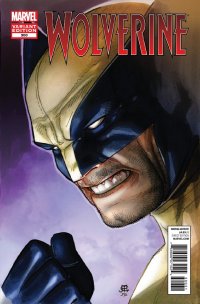
By Bart Bishop
The very first comic book I ever bought was Wolverine #23, way back in April of 1990. I actually still own it, even though the cover fell off a long time ago. I’m not a sentimental fellow, and in fact gave away or sold most of my old floppies a few years ago. I kept a few, however, and that included the vast majority of Peter David’s The Incredible Hulk run, and an almost complete run of the first hundred and twenty issues or so of the original ongoing Wolverine series. The majority of that is a classic run by Larry Hama, best known for his work on GI Joe, who is every bit as responsible for defining who Logan is today as Chris Claremont, made famous by his seminal work with the X-Men in the ’70s, ’80s, and ’90s (best not to mention his post-2000 X-Men work…). Claremont also wrote the first Wolverine limited series, with art by Frank Miller, in 1982. Like much of the work of Frank Miller in his formative years, this series became a defining text (possibly only surpassed by Barry Windsor-Smith’s Weapon X from 1991), insuring that thirty years later the character is still feeling the repercussions.
That series saw Wolverine venture to Tokyo, Japan to investigate the sudden calling off of his engagement with then- fiancée Mariko Yashida, half-sister of the Silver Samurai (and cousin of Sunfire, because all Japanese people are related in the Marvel Universe). While there he gets involved with an assassin named Yukio, and battles the Yakuza and the Hand (the ninjas that are always bugging Daredevil). Jump ahead to 2012 and Wolverine (v. 4) technically #21, but has been renumbered #300 for the sake of the anniversary, sees him return to Tokyo to show his respects to the fallen Silver Samura, meets up with Yukio, and fights the Yakuza and the Hand. The new ripples are Wolverine’s adopted daughter, Amiko Kobayashi, is kidnapped by the Hand and…Sabretooth shows up. That’s right, Sabretooth is alive again, after having been decapitated back in 2007. Isn’t that supposed to be the thing in comics you don’t come back from? If there’s a body, and it’s decapitated, then that’s final.
Who am I kidding? Nothing is final in superhero comic books, considering the perpetual episodic nature of the whole thing. It’s funny, there’s a comfort in the forced repetition of something like a Wolverine ongoing series. I grew up with the character, but hadn’t read him regularly since Mark Millar’s “Enemy of the State” storyline back in 2005. In that story, you guessed it, Wolverine fought the Hand. Now there’s a double edged sword here; I love the character, but there’s only so much that can be done with him. He either gets kidnapped by an evil organization that brainwashes him, runs around in the woods naked, makes out with Jean Grey, or goes to Japan. The 21st century has seen a few attempts at adding more dimension, with his mysterious past having been illuminated in 2001’s Origin and him remembering said past in 2005, gaining a cloned daughter in X-23 and discovering an evil son in Daken, but all of that isn’t real change; it’s just much more of the same.
Kudos must be given, however, to writer Jason Aaron: he’s put in his time with Wolverine, having written dozens of issues of volume 3, the entire run of Wolverine: Weapon X, the entire run of volume 4 so far, and the new series Wolverine & The X-Men. He knows this character and supporting cast, and has a handle on their voices and attitudes perfectly. What I love about the title character, and what Hugh Jackman understands with his cinematic portrayal, is that while Wolverine may be a trained killer he is actually a poet at heart. Little touches like having Wolverine reading Yukio Mishima’s The Sailor Who Fell from Grace with the Sea while on a plane evokes that nicely. What few writers understand is that Wolverine is not just a bruiser, but a brilliant tactician with a sardonic sense of humor. Aaron does a fine job of injecting this issue with that kind of gallows humor: for instance, the opening sequence in which the flight attendant passes out swords to the plane full of ninjas, or Wolverine taking the time to remove his shoes to fight sumo wrestlers in chapter four, and especially the Looney Tunes bit of mayhem when Wolverine barrels a Yakuza roadblock on his motorcycle only to fall for a booby trap left by Sabretooth.
The problem with the spectacle on display here is that there’s never any tension or danger. Wolverine, despite the fact that he died and went to hell in a recent story arc, is nigh invincible and proves so while fighting armies of ninjas, getting shot by a bazooka, and falling off a cliff. I remember during “The Dark Phoenix Saga”, back in 1980, that Wolverine got shot in the gut once while fighting the Hellfire Club, and was toppled over for several panels. These days not even being lit on fire and burnt down to the bone can slow the man down. Aaron compensates for this, however, by tackling the subject head on through humor and meta-commentary. The opening fight, for instance, results when Wolverine forces the issue; he’s as aware as we are of the inevitability of ninjas attacking him when entering Japan! As well, late in the issue an as-of-yet unnamed high ranking member of The Hand comments, “If a customer today wishes to procure our services, what do we have to offer him? Well, sir, we can have a dozen men in robes and masks jump through the window with swords and throwing stars. Or we can have two dozen men in robes and masks jump through the windows with swords and throwing stars.” Brilliant; a moment that works to offer insight into a new character while winking at the weary reader who thinks he’s seen it all before.
Speaking of which, the entire scene with the business suit wearing individual and the farmer works as a beautiful vignette, like a short story in of itself that has a wonderfully bittersweet ending. Speaking of vignettes, the same could be said of the scene introducing Sabretooth. It’s a strong bit of storytelling, using show rather than tell to demonstrate the threat of this man. Let it be said that even after existing for forty years, it cannot be taken for granted that a character’s personality, abilities, and history should be conveyed through every sentence they utter. Aaron manages to acknowledge what’s come before, but dare I say he allows a bit of humanity to ebb out of this blonde psychopath? Yes he kills, but it’s only when threatened. He also appears to have affectionate relationships, both with prostitutes he’s visited for years and a familiar accomplice that appears for a single panel at the end of the issue. He has a real motivation outside of trying to kill Wolverine for the millionth time, here working effectively for a boss while tricking the Yakuza out of money. When him and Wolverine face off, there’s obviously back-story with these two but it’s played rather light and flippant rather than “hey runt I killed Silver Fox YAAAAAAAAAAARRRRRRRRRRRRGGGGGHHHHHHH!!!!” and that’s so refreshing. This is the best characterization the character has received in years.
The art is very impressive. It’s a collaborative effort, with Adam Kubert, Ron Garney & Jason Keith, and Steve Sanders working on separate chapters. It’s relatively seamless, and Kubert does most of the heavy lifting which is appropriate because he is the most expressive and bombastic of these artists and has a long history with Wolverine. One of the more impressionable comic books of my childhood is Wolverine (v. 2) #75, which depicts the aftermath of Magneto tearing the adamantium from Wolverine’s body. This was Adam Kubert’s first issue with the character, and not only did it reveal the bone claws underneath the metal but kicked off a year and a half sub-run within Hama’s oeuvre, in which Wolverine traveled the world tying up loose ends because he thought he was dying. That was, in my opinion, the most engaging the character has ever been (when (when he was actually vulnerable), and Kubert did stellar work then and does so now as well.
His style hasn’t changed all that much in fifteen years, still quite reminiscent of the styles of his father and brother but a bit rougher with harsher lines and ragged detail. The cover, for instance, is an example of the way over-the-top fierceness inherent in the contemporary Wolverine, as he’s been shot to pieces (some bullet holes seeming forgetting basic anatomy as there would be unbreakable bones poking out) but still keeps coming. It’s a striking image, however, even if it’s reminiscent of hundreds of other covers depicting our hero. I’m one of those fans that thinks Wolverine should never wear his costume in his solo title, that these are supposed to be his adventures away from the X-Men, so I was pleased this is proved true for this issue. Kubert’s interpretation of the protagonist here is much less exaggerated than in the early days, but slightly more grizzled and mature than his work on Ultimate X-Men. Ron Garney actually does a strong Joe Kubert impression, although the colors look washed out and murky. Steve Sanders’ art is a little more cartoonish, but is fitting for the overtly cyber-punk section that he handled.
So this was an entertaining diversion. It’s comfort food, but much more like a burger from Five Guys than McDonalds (certainly as pricey, which may deter the casual reader). It has macabre humor, solid characterization, dynamic art, and a fast pace and drive towards a perceivable goal. There’s nice nods to continuity (Wolverine mentions being an Avenger, and Sabretooth cracks on Wolverine for being a headmaster now) without dragging the narrative down, and even the illusion of change: Yukio is crippled, Amiko is older, there’s a new Silver Samurai, etc. Aaron does a good job of keeping the ball rolling, and while this isn’t necessary at this point it’s at least classic Wolverine done right.
Rating: 




Out of a Possible 5 Stars
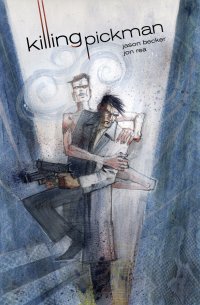 Killing Pickman (Archaia Entertainment, $19.95)
Killing Pickman (Archaia Entertainment, $19.95)
By D.S. Randlett
References to influences can be tricky to really pull off in any narrative art form. At one end of the scale, there’s something like the Not Another Blank Movie series, while at the other there’s something like Shaun of the Dead. When used correctly, a reference to one’s influences can comment on the older material while pushing the newer work forward in some way. There is, of course, a middle way, of which Killing Pickman is a zealous student.
Killing Pickman wears its influences on its sleeve, at times to its detriment. There are shout outs to Beowulf, Sam Raimi, H.P. Lovecraft, and John Woo, among others. These references don’t exactly hold the book back, but they also don’t add to the reader’s understanding of what has come before or even to the book in the reader’s hands. There’s ambition in Killing Pickman, but there is also a sense of trepidation that keeps the book from standing on its own two feet. Luckily, the ambition saves it.
The art is simply great. John Rea’s sketchy style reminded me of some Oscar Zarate’s work in A Small Killing, and there are some inventive storytelling flourishes throughout. Every chapter has a distinct visual theme, and the storytelling will spill into the gutters in some very fascinating ways. This works best when conveying mood during dialog scenes, but there are some instances where this style obscures some of the action. But on the whole, John Rea turns in a bravura performance.
The story, a supernatural yarn about a New York State policeman’s exploration of the mysteries surrounding an extraordinarily prolific kidnapper, takes a while to get going. But once the hits its stride, it rarely lets up on the sense of breezy, creepy fun. There are some missteps here and there. The dialog feels like it’s trying a little bit too hard at times, some of the characters feel pretty thin, and there’s not a whole lot of thematic oomph.
Killing Pickman is certainly flawed, but the sense of experimentation and fun that permeates it makes it worth seeking out.
Rating: 




Out of a Possible 5 Stars
Cobra Annual 2012 (IDW, $7.99)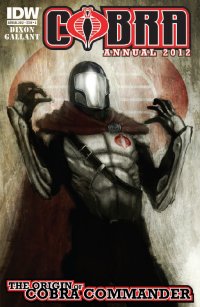
by Graig Kent
The first disappointment of Cobra Annual 2012 stems from the creative team. It’s not that writer Chuck Dixon and S.L. Gallant aren’t a solid team, responsible for much of the first volume of IDW’s G.I. Joe series, however, my initial assumptions were that series writer Mike Costa would be handling the script and it would be illustrated in a rougher, grittier style similar to that of Cobra series artist Antonio Fuso. With Dixon at the helm, expectations of what type of story was delivered within its pages shifted dramatically, as Costa’s Cobra is a nuanced exploration of the inner workings of a terrorist organization bent on global domination, while Dixon delivers more rock ’em, sock ’em, action-filled adventures. That’s not to say that Dixon is a stranger to characterization or drama but his general style of storytelling is so much more Mission Impossible 4 than Tinker Tailor Soldier Spy.
This squarebound, double-sized Annual (running a total 44 pages) promised on its cover “The Origin of Cobra Commander”, which is what it delivers indeed. After the finale of the “Cobra Civil War” that was running through the “Joe” titles, Cobra now has a new Commander in the form of Krake, a new character to the mythology as far as I’m aware. This issue dives in at the time of his birth (when they say origin, they mean it): “Born on the battlefield. In a country without a name. In a land without a flag.” It’s a generic Asian-Pacific setting rich in poppy fields, and thus addled with wars betwe. Raised to be menial labor and disposable, the child attempts to stop his mother’s rape with a stolen gun but winds up killing her along with her attackers. Hardened, he grows into a teenager, and dominates the landscape with his ruthlessness, devoid of conscience as well as any sense of selfishness, he’s a man playing a game simply because it’s the only game he knows how to play and he’s the best at it. That is, until he crosses a certain white-skinned, one-eyed foreigner named Bludd who introduces him to a whole new game.
This first act of the book is told in a quickly-cut manner, using a handful of panels to exemplify different stages in this man’s life, accompanied by overly dramatic prose like “He owns nothing but his pride. And his rifle. And no one will take either.” It gets the point across but that’s all it really does. There’s not a lot of investment in the character, just a look on the outside, sans any real nuance.
In the second act, Krake continues to draw Cobra’s attention but eludes their sway. Dixon drops the narration and draws out the sequences more, slowing time down dramatically, while still glancing through the defining moments. The third act slows things down even further to, really, one long sequence which finds Krake capitulating to Cobra’s recruitment tactics under the condition that he become completely anonymous, his face erased from existence, adopting a full-body suit, helmet and mask (like a cross between Darth Vader and The Killer from Wanted) to permanently hide his features.
The second disappointment of the book is in its inability to tell a complete story. The inference of “The Origin of Cobra Commander” being splashed on the cover is that the story within will not only tell us who this character is, but bring us up to the point where he becomes Cobra Commander. But it only takes things up to Krake’s in-costume debut as a Cobra soldier. Having only followed the Cobra series, and not Dixon’s various Joe series, I’ve had no exposure to Krake beyond his recent revelation as Cobra Commander, so leading this up to merely the point that it does leaves a lot unsaid (but I guess inferred) about the character’s rise to power within the Cobra organization. The fact is, for all the back story told about the character, there’s ultimately not much of a character there. He’s fairly one-note, and despite his psychopathic tendencies, he’s not all that interesting, certainly not as interesting as the leader of a world dominating empire should be.
As an effort, this feels like a typical Dixon “churn-it-out” story. He’s obviously put some thought into the character’s origins and what the necessary elements to tell the reader are to understand the character, but there’s little to no panache here, not in the character or in how his story is told.
Gallant’s art is capable, with scenes and settings stripped down to essentials without much busywork with lines or fine detail. He handles the rapid pace of the storytelling by serving it in a straightforward, no nonsense manner, which serves the story but never pushes beyond that. Gary Erskine provides some bold inks on Gallant’s lines, making it noticeably clean but the colorist, J. Brown, doesn’t use that clean space for anything but the expected, typical palette. It’s all around underwhelming and, at 8 bucks, worthwhile only to the most devoted Joe fan.
Rating: 




Out of a Possible 5 Stars
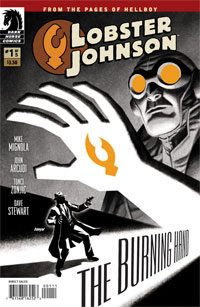 Lobster Johnson: The Burning Hand #1 of 5 (Dark Horse, $3.50)
Lobster Johnson: The Burning Hand #1 of 5 (Dark Horse, $3.50)
By Jeb D.
Nowadays, it seems like any comic that features street-level crime prior to the Clinton administration gets pegged as “noir.” But despite the typically dark tone of Mike Mignola’s “Hellboy-verse,” his stories tend to follow in the traditions of pulp, rather than noir, and the latest Lobster Johnson adventure (written by Mignola with John Arcudi) is setting the scene for another cracking good yarn.
It’s 1932, and Cindy Tynan is a sharp, fast-talking reporter in the Roz Russell/His Girl Friday mode. A dying man is found tied to a lamppost, having been scalped, evidently by bunch of local hoodlums made up as Native Americans (well, Cindy would have probably called them “Injuns,” but Mignola’s not out to offend modern sensibilities) who are then brutally dispatched by the mysterious Red Claw of Justice (I think I just made that up: call me, Mike, we can work something out). Naturally, her nose for a scoop starts quivering, and her investigation takes shape, though the cops (of course) regard her as an interfering busybody. While she looks for witnesses and clues, other puzzle pieces are introduced, including gangsters, a dark-haired femme fatale, a mysterious man whose face we never quite glimpse, and hints of the graft and greed that fuel the plot. As a first issue, it frames the story admirably; it’s light on action, but heavy on characterization and mystery–both, of course, borrowed from hundreds of the books and films that inspired Mignola, but carried off with an expertise that makes them feel classic rather than overdone.
Artist Tonci Zonjic seems to be having a grand old time with the period, as well, playing off conventions of Depression-era movies and classic comic strips (it feels like a nod to Will Eisner when the year is established in the first panel by a newspaper headline as it blows down a dark city street). There’s a clean simplicity to his work that, at first, feels odd in contrast with the more baroquely sinister stylings of Mignola, but he makes sure that all the surroundings and set pieces (skyscrapers to ocean liners to everything in between) have exactly the necessary level of detail. Dave Stewart’s coloring makes outstanding use of the naturally restricted tonal palette; so much so that the sight of a red slash of blood (notably when we first see the scalped man) is as startling to the reader as it is to the characters.
Like Hellboy himself, Johnson began as more of a cool pulpy concept than a fully fleshed-out character, and he’s well situated to operate on the fringes of a story, while Cindy and the forces surrounding her take center stage. The usual caveat about this probably reading better in trade applies, but if you still have an appreciation for the chapter by chapter build of a hard-boiled mystery, dig in.
Rating: 




Out of a Possible 5 Stars
The Shade #4 (of 12)(DC Comics, $2.99)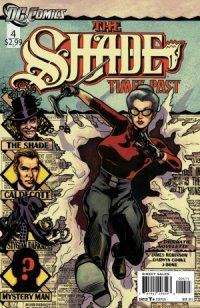
by Graig Kent
A few months ago in this column, I noted that James Robinson appeared to be back in prime form with this title, and with a “Times Past” interlude this issue illustrated by Darwyn Cooke and J Bone, he’s not yet proven me wrong. Though the first arc of the series suffered only in some mild pacing problems, this issue is practically 100 percent top shelf material (meant in the quality sense, not the “adult” magazine sense).
As was hinted at in my review of the first issue, this series is delving into the Shade’s mysterious past, and his equally mysterious private life, here at the same time. Set in the spring of 1944 with the war just about to reach its climax, the Shade gets embroiled in a Nazi assassination plot in America. A wealthy industrialist named Caldecott has sunk the entirety of his family and company money into the war effort and his dramatic impact has made him a target. Shade, then a rogue of the highest order, takes an uncommon interest upon learning of the scheme and enlists the help of a pair of unlikely allies (“adventurers” as he calls them) in Vigilante and Madam Fatal, the latter of which has a deliriously entertaining revelation to make which Robinson treats as a non-sequitur but also with subtlety and aplomb, the type of which we haven’t seen from him since the early days of Starman. There’s a little hinting at what’s in the pipeline for the series in the final pages, which sticks out of the natural flow of conversation, but otherwise, it’s perhaps Robinson’s finest effort in the past 15 years.
Cooke’s art here isn’t quite up to the caliber of his more prominent work like New Frontier or the Parker series, working in a looser, less refined style though retaining much of the dynamic movement and retro sensibilities that have made him popular. Any relaxation in Cooke’s work are fortified J. Bone’s crisp inks, making lovely containers for Dave Stewart’s masterful color sense.
From Tony Harris’ pulp-inspired cover to the lively adventure serial plot, this is pure entertainment, working exceptionally well as both a done-in-one and thematic tie to the overall series.
Rating: 




Out of a Possible 5 Stars
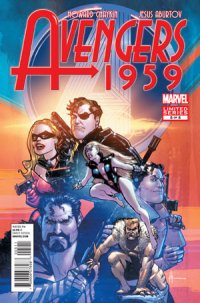 Avengers 1959 #5 of 5 (Marvel, $3.99)
Avengers 1959 #5 of 5 (Marvel, $3.99)
By Jeb D.
Howard Chaykin’s attempt to drag Nick Fury into his familiar casserole of political and corporate venality, fascism, sexual repression, stocky men, and curvaceous women, wraps up this week, as Fury and his Eisenhower-era group of “disavowed” Avengers take on their opposite numbers in the Agents of Icon (with lashings of the Dread Dormammu and proto-Black Panther for spice). As you’d hope, it brings much of the good ol’ knock-down slam-bang, in Chaykin’s highly idiosyncratic style. From anyone else, the constant barrage of backstory text boxes over the head of each fighter would be maddening, and it is reasonable to ask: if Hermann Goering’s penchant for dressing up in leather and fur was relevant to Doctorangutan’s participation in these events, why he didn’t actually… I dunno… WRITE it into the story? But, as I say, that’s Chaykin, one of the industry’s genuine originals, and, in any medium, the best artists are always the obsessive ones, anyway.
Apart from savoring the punchups, the reader has the fun of watching Chaykin build up a little personal corner of the Marvel Universe for himself: the John Steed-like character of McTeague turns out to be more than a gloss on the shared name “Avengers”: while he never does pair up with a Mrs. Peel surrogate, he has a few revelations toward the end that suggest he could feature in a Sentry-like role, peeling back previously hidden (OK, retconned) secrets of the early days of the Marvel Universe, in future series.
Being a climactic showdown and all, there’s not a ton of analysis to be done regarding this comic; if you’re a fan of Chaykin’s cheerful brutality and fresh-faced cynicism, you’ve probably been onboard for four issues, and have already devoured this one, hoping for more. If you’re one of those readers who takes a more, shall we say, “measured” approach to Chaykin’s sensibilities, I’d at least suggest you consider browsing the trade in your LCS, to see if it’s for you: like Rick Remender’s Punisher, Chaykin’s 1959 Avengers are a highly idiosyncratic take on familiar Marvel characters, by a creator with a vision that’s unique, to say the least.
Rating: 




Out of a Possible 5 Stars